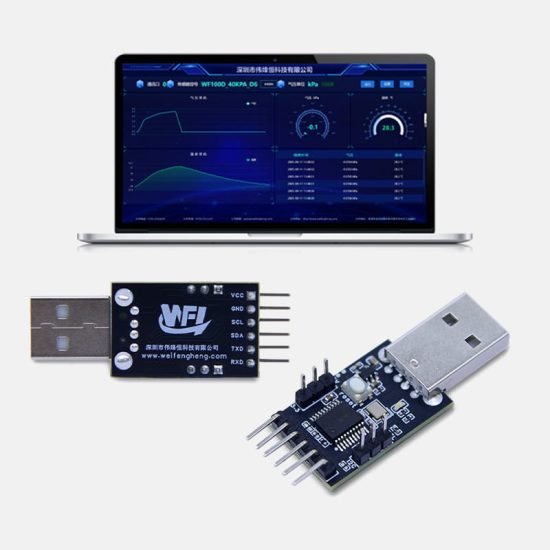Каталог
This comprehensive document covers atmospheric pressure sensor calibration methods and wireless sensor advantages. Calibration includes pre-preparation with environmental stability, static calibration using standard barometers, dynamic calibration under varying conditions, and self-calibration features. Wireless sensors offer flexibility, real-time data transmission, easy installation, scalability, environmental adaptability, data integration, energy efficiency, safety, cost-effectiveness, and enhanced monitoring capabilities with IoT integration.
1. Pre-Calibration Preparation
Before conducting calibration, it is essential to ensure that the sensor is in a stable state and that environmental conditions (such as temperature and humidity) meet calibration requirements. Additionally, calibration equipment must be prepared, including standard barometers, calibration software, and connection cables. Temperature compensation is crucial during this phase, as pressure sensors are highly sensitive to temperature variations. Proper warm-up time (typically 30-60 minutes) should be allowed to ensure thermal stability.
2. Static Calibration
Static calibration is performed under fixed atmospheric pressure conditions, typically using a standard barometer as reference. The procedure includes:
Step 1: Place the atmospheric pressure sensor and standard barometer in the same environment, ensuring both are under identical pressure conditions.
Step 2: Record readings from the standard barometer.
Step 3: Compare the pressure sensor readings with the standard barometer readings and calculate deviations.
Step 4: Adjust the sensor’s calibration parameters based on the deviation until readings align with the standard barometer. Multiple measurement points across the sensor’s operating range should be tested to ensure linearity and accuracy throughout the entire measurement spectrum.
3. Dynamic Calibration
Dynamic calibration is conducted under varying pressure conditions to simulate actual operating environments. The steps are:
Step 1: Place the atmospheric pressure sensor in an environment where pressure changes can be controlled, such as a pressure chamber.
Step 2: Gradually change the pressure chamber’s pressure and record readings from both the pressure sensor and standard barometer.
Step 3: Analyze data to determine the sensor’s response characteristics under different pressure conditions.
Step 4: Based on dynamic calibration results, adjust the sensor’s dynamic calibration parameters. Hysteresis effects should be evaluated by conducting both ascending and descending pressure cycles to identify any systematic errors in the sensor’s response.
4. Self-Calibration
Some modern atmospheric pressure sensors feature self-calibration capabilities that can automatically perform calibration. The steps include:
Step 1: Initiate the sensor’s self-calibration program.
Step 2: The sensor will automatically adjust its internal parameters to ensure measurement accuracy.
Step 3: Monitor the self-calibration process to ensure no errors occur. Advanced sensors may incorporate machine learning algorithms to continuously improve calibration accuracy based on historical data and environmental patterns.
5. Regular Calibration
To maintain measurement accuracy, regular calibration of atmospheric pressure sensors is recommended. Calibration intervals should be determined based on sensor specifications, environmental conditions, and application criticality. High-precision applications may require monthly calibration, while standard applications may suffice with annual calibration schedules.
Advantages of Wireless Atmospheric Pressure Sensors
1. Flexibility and Portability
Wireless atmospheric pressure sensors do not require physical connections to data loggers or monitoring systems, making them easily deployable in different locations, particularly in environments where wiring is challenging.
2. Real-time Data Transmission
Wireless atmospheric pressure sensors can transmit data in real-time, which is crucial for applications requiring immediate response (such as meteorological monitoring and disaster warning systems).
3. Easy Installation and Maintenance
Since no wiring is required, the installation and maintenance workload for wireless atmospheric pressure sensors is minimal, reducing costs and complexity.
4. Scalability
Wireless networks allow for easy addition of more sensor nodes, facilitating expansion of monitoring networks.
5. Environmental Adaptability
Wireless atmospheric pressure sensors are typically designed to be more robust and durable, capable of adapting to harsh environmental conditions.
6. Data Sharing and Integration
Wireless sensors can easily integrate with existing data management systems or cloud platforms, enabling centralized data management and analysis.
7. Energy Efficiency
Many wireless atmospheric pressure sensors adopt low-power designs and can operate on battery power, suitable for long-term deployment.
8. Safety
Wireless sensors reduce the need for on-site wiring, lowering electrical safety risks.Many wireless atmospheric pressure sensors adopt low-power designs and can operate on battery power, suitable for long-term deployment.
9. Cost Effectiveness
Although initial investment may be higher, wireless sensors can provide better cost-effectiveness in the long term by reducing wiring and maintenance costs.
10. Environmental Monitoring
Wireless atmospheric pressure sensors in environmental monitoring applications can provide broader data coverage, helping to better understand and predict environmental changes.
11. Enhanced Network Reliability
Modern wireless pressure sensors often incorporate mesh networking capabilities, ensuring data transmission continuity even if individual nodes fail. This redundancy significantly improves overall system reliability and reduces data loss risks.
12. Advanced Data Analytics
Wireless sensors enable sophisticated data analytics through cloud computing platforms, allowing for predictive maintenance, trend analysis, and automated alerting systems that can identify potential issues before they become critical.
Заключэнне
Calibration of atmospheric pressure sensors is crucial for ensuring measurement data accuracy. By adopting correct calibration methods, sensor performance and reliability can be improved. Wireless atmospheric pressure sensors, with their flexibility, real-time capabilities, and ease of deployment, play an increasingly important role in modern monitoring systems. As Internet of Things (IoT) technology continues to evolve, wireless pressure sensors are becoming integral components of smart city infrastructure, enabling comprehensive environmental monitoring and contributing to sustainable urban development. With technological advancement, the application scope of wireless atmospheric pressure sensors will further expand, providing more efficient and accurate monitoring solutions for various industries.
Прыведзенае вышэй увядзенне толькі драпае паверхню прымянення тэхналогіі датчыка ціску. Мы працягнем вывучаць розныя тыпы сэнсарных элементаў, якія выкарыстоўваюцца ў розных прадуктах, як яны працуюць, а таксама іх перавагі і недахопы. Калі вы жадаеце атрымаць больш падрабязную інфармацыю аб тым, што тут абмяркоўваецца, вы можаце праверыць адпаведнае змесціва далей у гэтым кіраўніцтве. Калі ў вас няма часу, вы таксама можаце націснуць тут, каб загрузіць падрабязную інфармацыю аб гэтым даведніку Датчыкі датчыка ціску паветра PDF дадзеныя.
Для атрымання дадатковай інфармацыі аб іншых сэнсарных тэхналогіях, калі ласка Наведайце старонку датчыкаў.


